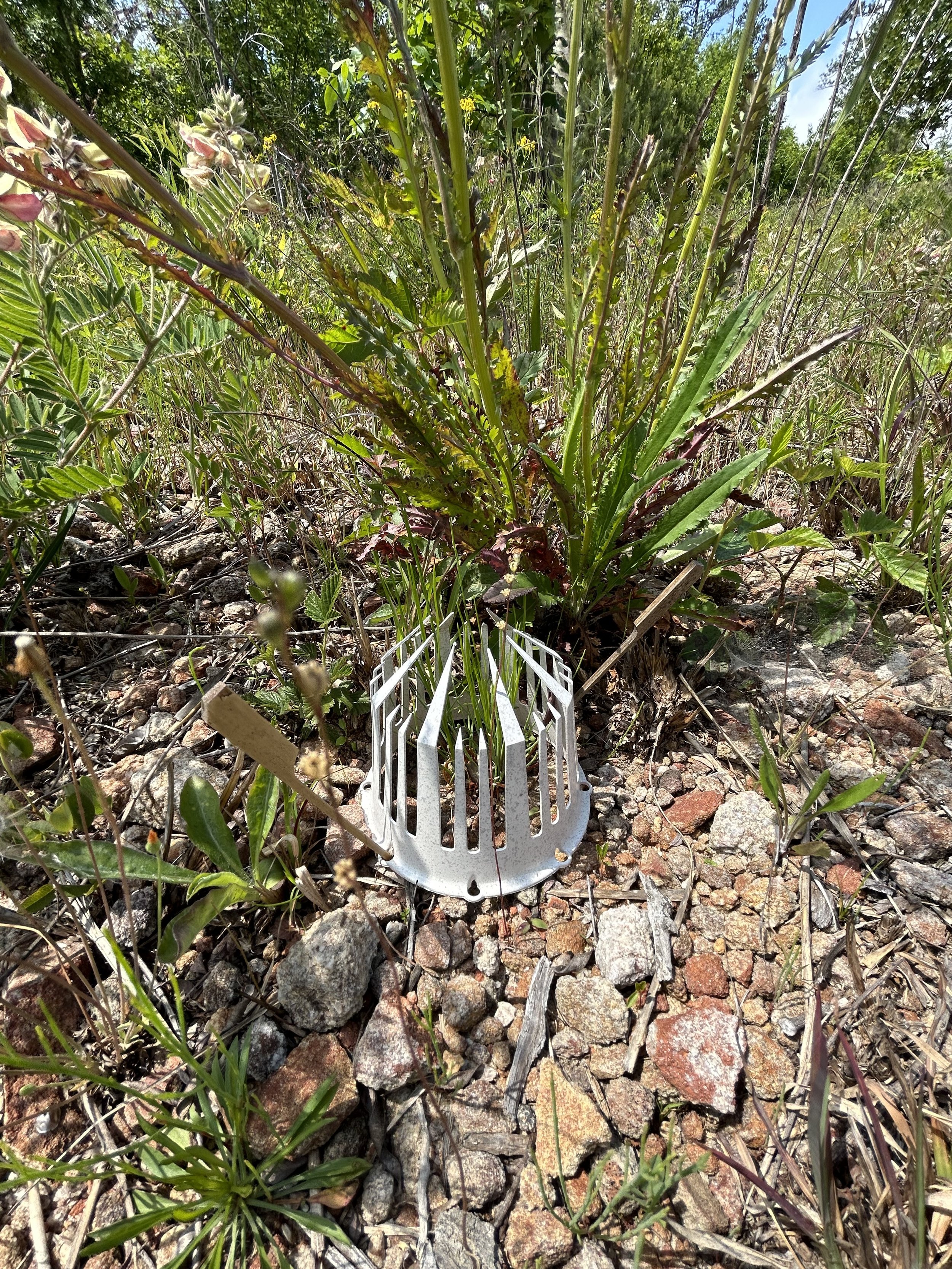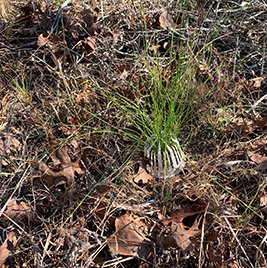
THE MANUFACTURED PROTOTYPE
The basic idea of a Seed Crown™ could be embodied in a variety of configurations and manufactured in an assortment of materials and sizes. After much trial and error, the first manufactured prototypes use the design shown below to the right:
The key goals for any Seed Crown™ design are to make it hard for animals to get inside the device (or at least not worth the trouble) while making it easy for plants to get out, and for it to degrade without harmful side effects under a normal forest management regime. I am certain that the initial design can be improved, both in performance and ease of manufacture. What I believe to be important features of this design include the open bottom with peg holes to for easy installation over a planted seed or seedling and a solid lower base wall with separate vertical members that act as palisades. The transition from a solid base to abundant side palisades and then to comparatively fewer spikes bending over the top opening recognizes that larger birds and mammals likely to approach from above can be deterred by lesser obstruction than smaller mammals or even insects that might approach closer to the ground. Also, having the spikes bend inward over the top may help deflect leaf litter and definitely makes stacking much easier. The absence of horizontal elements above ground level and the reducing number of vertical impediments moving higher from the ground serve to reduce interference with plants growing inside the Seed Crown™ (whether desired seedlings or other cohabitant vegetation).
While Seed Crowns™ can be made from a wide range of materials, the optimal solution would combine low costs, non-toxicity, a certain degree of durability, and the trait of melting or burning in a prescribed fire without adding material heat. If a material could ring the forgoing bells and also genuinely biodegrade even without fire, all the better.
The initial run of manufactured prototypes included versions made from plant-based poly lactic acid (“PLA”) and traditional polypropylene (“PP”) plastic materials, and PLA and PP mixed with wheat straw. While PLA may be the least expensive of the plant-based plastics in today’s market, it is still almost twice as expensive as PP and, while theoretically compostable under ideal conditions, it is nearly as persistent as PP in real world environments. For the relatively low quantity initial prototyping runs using injection molding technology, units of the PP version cost just under $0.25 while PLA was just under $0.45. The least expensive plastic food containers are usually manufactured by thermoforming. My hope is that the combination of refinements to the design and materials along with bulk pricing can get the manufacturing cost well below $0.20 per unit for large runs, inclusive of the costs separate pegs or skewers. As explored further below, the jury is still out on how effective prescribed far might be in consuming shelters made from different types of materials.
One last feature deserves special mention. The manufactured prototypes are designed to stack in sleeves like drink cups. A package of 50 units stands about 15” tall and weighs about 1.75 lbs. As a result, they are sufficiently lightweight and compact for an individual to carry a day’s worth of shelters in a backpack along with a hardy lunch and drinking water, making planting in remote locations far more feasible than is the case with nursery stock.
Longleaf seedling with Seed Crown™ at two weeks
Longleaf seedling with Seed Crown™ at six months
Longleaf seedling with Seed Crown™ at twelve months
As explored in the Trials section, field testing of manufactured prototypes begin in October 2022. A video demonstration of the precision direct seeding technique is linked below and, or you can go to the Precision Direct Seeding YouTube Channel to view a demonstration video.
Longleaf Precision Direct Seeding using Seed Crown™
Effects of Prescribed Fire
Careful study of the effects of prescribed fire on Seed Crowns™ devices or on seedlings established with precision direct seeding techniques remains to be done. To date, the PLA versions have been exposed to one very low intensity fire conducted 14 months after the seeds were planted within a very recently thinned, 25 year-old loblolly plantation. Consequently, the available fuels were only recent loblolly needle cast, residual harvest slash, and one full year of herbaceous ground cover growth. As the photos below show, while the seedlings appear just fine, the degree to which the PLA material melted was highly variable and almost no locations saw the material completely consumed. Further, in many cases, the partially melted material reformed in configurations that might impede growth.
Example 1
Example 2
Example 3
Results of prescribed fire on 14 month-old seedlings under PLA shelter.
The fact that the pine cone shown in the middle photo made it through shows that the fire was not especially hot. Other experiments suggests the PLA material would likely disappear more completely under what might be more typical conditions. However, as explained under the “Trials” tab, the PLA material also showed signs of warping in the normal summer heat of central Georgia. Therefore, PLA may not be the best material for applications where shelters are to be left in place after planting.
Some of the initial manufactured prototypes were made from a PP and wheat-straw blend. I conducted a low-intensity demonstration burn in a roughly 10’ x 10’ understory area that had been burned the previous year so, similar to the above-described conditions, the fuels were only new grass and leaves. The PP material melted and partially ignited but without harming the under 2 year-old seedling. As shown below, however, this test burn also left some plastic residue that cemented small patches of sand and gravel:
Demonstration of PP Seed Crown™ minutes before burn
Demonstration of PP Seed Crown™ minutes after burn
Demonstration of PP Seed Crown™ 4 months after burn
Like the PLA residue shown earlier, the PP residue is loose on the surface and fairly brittle and I suspect it would be consumed in the next prescribed burn. Unlike PLA, the PP shelters showed no signs of warping in the summer sun. Thus, whether to leave PP shelters in place to be consumed by prescribed fires may involve tradeoffs or balancing between the negative aesthetics of leaving visible residue for some period of time, the costs of individual shelters, and whether expending the labor to recover shelters results in lower overall costs as compared to leaving shelters in place.
As noted earlier, the ideal Seed Crown™ material would be inexpensive and hold its shape yet completely biodegrade either with or without application of prescribed fire. The search for that material continues. Suggestions would be most welcome!









